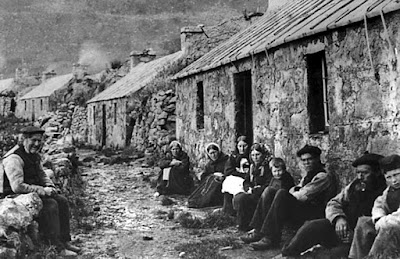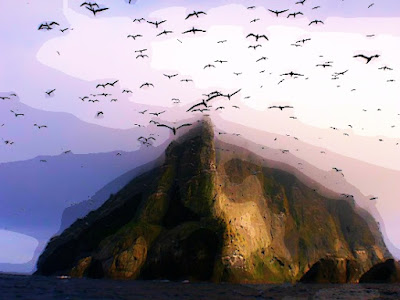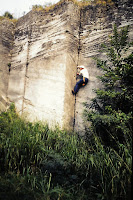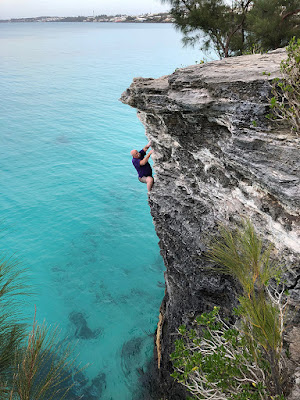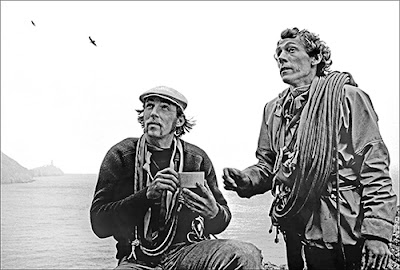'The man who cannot climb it never gets a wife in St. Kilda.' So said Maclean in his 'Sketches of the Island of St. Kilda,' a scarce book, published in Glasgow in 1838. In view of the fact that the natives of this remote island formerly subsisted largely on sea-birds and eggs, it is not unreasonable to suppose that a girl of St. Kilda, having in view her future welfare, should establish some sort of test whereby to judge her lover's ability as a climber. Sir Robert Moray, in a paper communicated to the Royal Society in 1678, describes the dangers connected with the capture of sea-fowl by the men of Hirta on the apparently inaccessible Stacca Donna.
There can be no doubt that this is the stack now called Stack-na-Biorrach. After they landed, he says, a man having room but for one of his feet, he must climb up 12 or 16 fathoms high. Then he comes to a place where, having but room for his left foot and left hand, he must leap from thence to another place before him, which if he hit right the rest of the ascent is easie, and with a small cord which he carries with him he hales up a rope whereby all the rest come up. But if he misseth that footstep (as often times they do) he falls into the sea and the company takes him in by the small cord and he sits still until he is a little refreshed and then he tries it again; for everyone there is not able for that sport.
Martin, in his 'Late Voyage to St. Kilda,' published in 1698, describes the ascent of 'the famous rock Stackdonn, as a Mischievous rock.....
for it hath prov'd so to some of their number, who perished in attempting to climb it; it is much of the form and height of a steeple; there is a very great dexterity, and it is reckoned no small gallantry to climb this rock, especially that part of it called ‘the Thumb’, which is so little, that of all the parts of a man's body, the thumb only can lay hold on it, and that must be only for the space of one minute; during which time his feet have no support, nor any part of his body can touch the stone, except the thumb, at which minute he must jump by the help of his thumb, and the agility of his body, concurring to raise him higher at the same time, to a sharp point of the Rock, which when he has got hold of, puts him above danger, and having a rope about his middle, that he casts down to the boat, by the help of which he carries up as many persons as are designed for fowling.
At this time; the foreman, or principal climber has the reward of four fowls bestowed upon him above his proportion; and perhaps, one might think four thousand too little to compensate so great a danger as this man incurs. He has this advantage by it, that he is recorded among their greatest heroes; as are all the foremen who lead the Van in getting up this Mischievous Rock.
This quaint description was written 215 years ago, but every writer of importance on St. Kilda since that date has also mentioned this rock. Macaulay (grand-uncle of Lord Macaulay), in his 'History of St. Kilda,' 1764, appears to be the first to mention Stacki-birach, and says 'within a pistol shot of it lies Stacki-don or the Stack of no consequence, being the only rock within the territories of Hirta where the fowls do not hatch.' Then he says that Stacki-birach derives its name from 'ending in a spire.' Seaton, in his 'St. Kilda, Past and Present,' 1878, which is the most exhaustive account of the island yet published, does not allude to the confusion of names. Heathcote, however, in his attractively illustrated book on St. Kilda, published in 1900, takes it for granted that the Stack referred to by Martin as 'Stackdonn' was that which is now known as Stack-na-Biorrach. Martin does not give the height, but Macaulay gives it as 40 feet; Maclean as 400 or 500 feet.
Heathcote is, in my opinion, correct in putting it at 'about 240 feet.' Macaulay's 40 feet was perhaps intended for 400, as the old writers were given to exaggeration. Heathcote appears to have been the only writer on St. Kilda who ascended any of the Stacks, all of which rise out of the ocean. He states that he has done a lot of climbing in Skye and a certain amount in Switzerland, and thinks he may claim to be a tolerable climber, and in this he is probably correct. For although he did not attempt Stack-na-Biorrach, which he says is the most difficult climb, he scaled Stack Lii, the height of which he gives as 533 feet, and the cover of his book is illustrated with a striking picture showing the commencement of the ascent. He failed to trace the story that in order to get a wife in St. Kilda it was necessary to climb Stack-na-Biorrach.
In this his experience agrees with mine. The truth is that, although not a necessity, it was looked upon as a great feat amongst the islanders, where for hundreds of years the chief food of the inhabitants was obtained from the lofty precipices and Stacks. In fact there is no part of the world, as far as I am aware, where the practical advantage of being a skilled cragsman was so well recognised.
The chief topics of conversation in this out-of-the-way island are climbing and birds. A visit to Switzerland in 1882, during which the Schreckhorn, Finsteraarhorn, Jungfrau and Matterhorn, and an equal number of high passes were negotiated within ten days, and the fact that a certain rivalry existed between myself and an elder brother who first ascended the Eiger, induced me to visit St. Kilda in 1883, as I wished to test the ability of the natives as cragsmen, to compare them with Swiss guides, and to study the fauna and flora of this remote island, of which little was then known. It is thirty years ago next June since I ascended Stack-na-Biorrach, and therefore I trust I shall not be accused of hasty self-advertisement; indeed, my chief object in writing is to give the members of the Alpine Club an account of a climb which the older writers have attempted to describe on second-hand information; and, moreover, I fear that even the St. Kildans themselves will soon cease to ascend the rock, as they no longer subsist to the same extent on sea-birds and there is not the same necessity for dangerous rock-climbing.
But I have not yet described the St. Kilda group, which lies about fifty miles west of the Sound of Harris, and about one hundred west of the Scottish mainland. It consists of one large island, three miles long and two broad, rising to a height of 1372 feet, and two smaller ones—Soa and Borera, each about 1200 feet in height, and three Stacks—Stack-an-Armin, Stack Lii, and Stack-na-Biorrach, besides smaller rocks. Formerly communication with the mainland was of rare occurrence. Lady Grange was conveyed there in 1734, and was not released for eight years. Since David McBrain's steamers began running there, from thirty to forty years ago, intercourse with the outer world in summer time has been frequent, if uncertain. Fearing I might be left on the island all the winter, I arranged with McBrain to send a special steamer to take me on in September for the sum of £30. There was no necessity to take advantage of this arrangement, as his ordinary steamer took me off in good time. Not knowing Gaelic, I brought an interpreter with me from Glasgow, but, as he was afraid to go within ten yards of any cliff and did not understand the St. Kilda dialect, he was useless, save as caretaker of an old Crimean tent which we pitched on the only level patch (about ten yards square) near the landing-place.
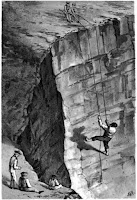 The natives could not speak a word of English, and it was nearly a fortnight before they permitted me to accompany them in catching fulmar petrels on the ledges along the face of the great Connacher (1200 feet). They wanted to test my ability. I remember one day walking along its edge and seeing a stout stick firmly embedded in the earth about three yards from the face, with a rope round it. I was sure someone was below catching birds, so descending about 100 feet I came upon another rope, also fastened round a stick, embedded in the next ledge. This I also descended and came to a second ledge on which two men roped together were busy catching birds with long fishing-rods, to the end of which horse-hair nooses were attached. Having obtained permission to try my hand and being rewarded with success, the natives became very friendly. Of course I had my boots off. If you don't take them off it is done for you compulsorily.
The natives could not speak a word of English, and it was nearly a fortnight before they permitted me to accompany them in catching fulmar petrels on the ledges along the face of the great Connacher (1200 feet). They wanted to test my ability. I remember one day walking along its edge and seeing a stout stick firmly embedded in the earth about three yards from the face, with a rope round it. I was sure someone was below catching birds, so descending about 100 feet I came upon another rope, also fastened round a stick, embedded in the next ledge. This I also descended and came to a second ledge on which two men roped together were busy catching birds with long fishing-rods, to the end of which horse-hair nooses were attached. Having obtained permission to try my hand and being rewarded with success, the natives became very friendly. Of course I had my boots off. If you don't take them off it is done for you compulsorily. For, on another occasion, after landing on the island of Borera and proceeding to climb without removing them, I felt myself pulled down from behind, one of the islanders grasping my arms and waist together while the other proceeded to unlace my boots. The ropes by which the men descended the Connacher cliff were of hemp and rather heavy, but the line between the two men on the ledge was made of horse-hair and was light. In 1883 there were no horses on St. Kilda, but many cows. Martin, in 1698, said there were only three ropes in the whole island, each fathoms long. 'The chief thing,' he says, 'upon which the strength of these ropes depends is cow-hides, salted, and cut out in one long piece. This they twist round the ordinary rope of hemp, which secures it from being cut by the rocks.' Macaulay says (1764) that 'a rope is the most valuable implement that a man of substance can be possessed of in St. Kilda.
In his will he makes it the very first article in favour of his eldest son,' and 'it was reckoned equal in value to the two best cows on the island.' The rope alluded to by Macaulay appears to have been made entirely of cow-hide. I brought two Alpine Club ropes with me, the red central thread being regarded as a great curiosity by the natives. They would use neither of them. But they were very useful when attached to the top of the tent, preventing it from being blown into the sea on two very stormy days. After repeated entreaties, and when the natives had tested my ability in various ways, they consented to bring me to Stack-na-Biorrach. The wind was light, and the entire able-bodied population assisted in pushing the boat over the rocks into the sea. During this operation a crowd of about twenty dogs barked furiously.
There were eight rowers, my nephew, and myself in the boat. The natives are very religious, and a prayer was said before starting. We rowed round the Doon and under the tremendous cliffs of the western face of St. Kilda, the great Atlantic swell making a white fringe along the rocks and booming in the great caves. In about an hour's time we came to a narrow sound between the island of Soa and the large island, and the boat unexpectedly stopped before a perpendicular and in some places overhanging Stack, which looked to me absolutely inaccessible.
The men talked in Gaelic, not a word of which I understood. One of them put a horse-hair rope around his waist. I could not imagine what they intended to do. For to ascend the rock immediately opposite appeared an utter impossibility, and my heart sank within me when they shouted ' Stack-na-Biorrach, Stack-na-Biorrach!' Donald McDonald, the man with the horse-hair rope round his waist, stood in the bow of the boat. Another man held the rope slack, and, watching his opportunity as the boat rose on the top of a swell, McDonald jumped on a small ledge of slimy seaweed below high-water mark. There was a momentary stagger, but he kept his balance, and fastened himself to the rock by holding on apparently to the barnacles with which it was covered. He then proceeded upwards by sticking his fingers and toes into small wind-worn cavities on the western face. The rope was gradually slackened, and at a height of about thirty feet he turned to the east, getting on a small narrow ledge, unseen from below, which could not have been more than two or three inches wide.
The whole of this performance was remarkable, especially having regard to its surroundings, the steeple-like rock rising from the ocean off the very wildest part of this remote island, the boatmen shout-ing in Gaelic to the climber, the great surge of the Atlantic threatening every moment to drive us against the cliff, and the horse-hair rope alternately slack and tightened as the boat rose and fell. At a height of about 30 or 40 feet McDonald stood on a projecting knob, about two feet square, right over the boat. He hauled up another rope and fastened it round the knob. There were now two ropes to the boat. Donald McQueen, tapped me on the shoulder and explained by signs that I was to ascend, boots of course being first taken off. At that time I could ascend a rope easily hand over hand; the swaying of it between the boat and the cliff made it less perpendicular at intervals and therefore easier, and I soon stood on the knob beside McDonald. I recollect every incident as if it only happened yesterday.
He pressed me against the face of the cliff, and, to my horror, Donald McQueen now proceeded to ascend the rope. For the life of me I did not know where he was going to stand, and to this day I am puzzled to know how we three men contrived to stand on this projection. Fearing every moment that I would fall, I shouted to pull the boat from the rock, so that in case of accident I should drop into the sea, and not into the boat from a distance of about 40 feet. McQueen now put the rope round his waist and took the lead up a ledge two feet wide, wet with spray, which sloped at a very steep angle upwards. Having ascended this he grasped a narrow horizontal ledge about four inches wide and sloping outwards, so that the fingers slipped readily, and, with his feet dangling in the air, proceeded to jerk himself along this ledge by getting a fresh hold every time with each hand alternately. It was about 15 feet long.
McDonald held the horse-hair rope which was round McQueen's waist in his hand. This, no doubt, gave him a false sense of security, but otherwise was absolutely useless, for, had McQueen fallen, they would have both tumbled into the sea. McQueen now stood on another projection of a more satisfactory character than the first, about 70 feet over the sea, and beckoned me to follow him. The horse-hair rope was placed round my waist, and with McQueen on one side and McDonald on the other, holding the rope, I proceeded along the ledge, dangling without any foothold. Had it not been slippery with the droppings of guillemots I might have succeeded, but when midway I slipped, and, unable to recover my grip, would have fallen had not the two men simultaneously tightened the horse-hair rope with a powerful jerk, raising me a foot, during which I caught sight of a small lump sticking up, and, grasping this anxiously with one hand, was soon safely landed by McQueen at his end of the ledge.
Whether this slight projection, which really makes this traverse possible, was The Thumb referred to by Martin more than 215 years ago I cannot say? McDonald now came along with apparent ease, and we all stood together for the second time. There was more room here, but the cliff above was overhanging and I was curious to see what would happen next. The rope was unloosed from everybody, and one of the men made a lasso of it and proceeded to throw it round a projection about 14 feet overhead.
After five or six failures it was successfully lassoed and the rope tested by vigorous pulls to see whether it would give way. Having satisfied themselves that it was secure McQueen ascended, I followed, and then McDonald, all hand over hand. We were now about 80 feet above the water, and as the stack was no longer perpendicular or overhanging I shall not give minute details of the remainder of the climb, which was not more difficult than many first-class clubmen could contend with. It was interesting, however, and the view from the top was very fine. Hundreds, almost thousands, of guillemots scurried and fluttered or flew into the ocean below. The top was not flat, like the pinnacles on Farne Islands, but weather-worn and uneven. My thoughts were not, I fear, ornithological, but rather concentrated on the problem 'How shall I ever get down?'
However, the descent was accomplished with less assistance than the ascent, and I caught ‘The Thumb’ this time. The boatmen exclaimed 'Sauna' which, being interpreted to me, signified that I was a great climber, like a famous St. Kildan of that name. The best photograph I have seen of Stack-na-Biorrach faces page 124 in Kearton's well-known and beautiful book 'With Nature and a Camera,' published in 1902. It is the left-hand stack in that photograph. Even still, although the people on the island are getting spoiled by visitors, St. Kilda and its inhabitants are full of interest. I do not know whether either of the men who accompanied me in the ascent of Stack-na-Biorrach is alive.
My nephew took a photograph of us after we returned. It shows exactly how we were attired for the climb; horse-hair rope and all. Thirty years ago there was no Ordnance sheet of St. Kilda, and I believe none has yet been made. The best maps I know of are the Admiralty chart and the map at the end of Heathcote's book. The ankles of the natives are tremendously developed. Kearton, who is a powerful man, gives in his book a photograph of his own ankle and that of a native. Heathcote, at the end of his book, hopes that he has deterred most people from going to St. Kilda. I am afraid his interesting volume will have exactly the opposite effect, but I do not expect his happy hunting-grounds, as he expresses it, will ever be 'invaded by a host of Sassenachs.'
My last visit to St. Kilda, in 1896, was very brief, and was made when returning from an expedition to the still more remote island of Rockall, 170 miles further west in the Atlantic; nobody has, I believe, been able to land on this island for over half a century. I saw Donald McDonald, then looking very poorly, and believe Donald McQueen was dead, for I could not find him.
Richard M Barrington
This article first appeared in the May 1913 issue of the Alpine Journal



